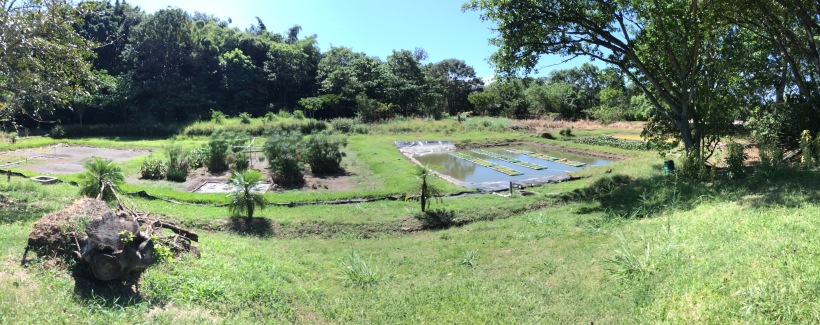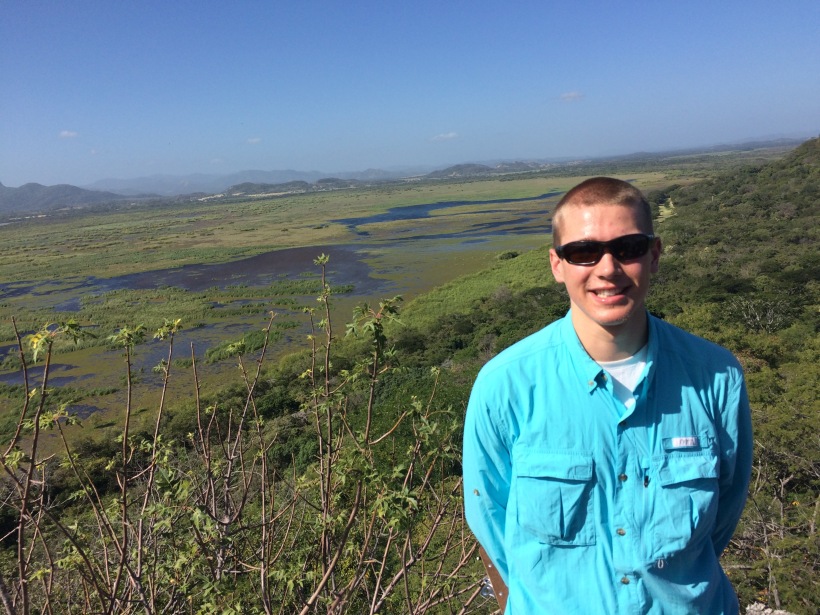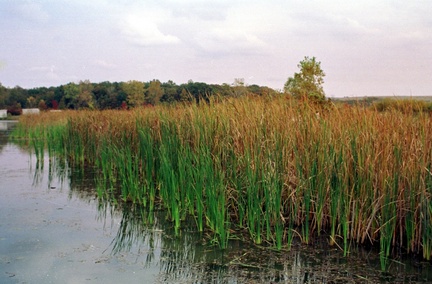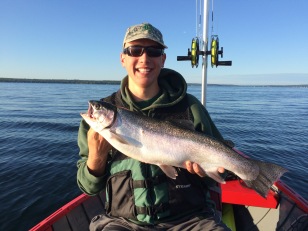General In-Country Observations
While in Costa Rica, we visited two wetlands– the constructed treatment wetland system at Fabio Research Facility and the natural wetland at Palo Verde National Park. Seeing both wetlands provided an interesting perspective on the importance of wetlands in a tropical climate. Now that I’ve had to time to reflect on what I learned from visiting the two wetlands, I can make some general conclusions about the the composition, structure, and function of the wetland ecosystems in Costa Rica.
We spent a substantial amount of time at the Fabio treatment wetlands. First, we did an initial visit to learn details about the system and how it is interconnected with the anaerobic digester, and then we returned later to work on a design project for harvesting the wetland plants. The wetland system at Fabio has four cells, each 100 square meters in area. First is a sand filter where water is inputted on top and filtered down through layers of sand before being sent to the second cell. This sand filter wetland is currently offline at Fabio. The second cell is a vertical flow wetland where water moves vertically through the soil as vegetation like papyrus, iris, and canna indica uptake some of the nutrients from the water like phosphorus and nitrogen. Solids that pass through the wetland collect on a thin layer of geotextile that must be cleaned every five weeks to reduce clogging. The water can be circulated twice a day to maximize solid and nutrient removal before it flows to the third cell. (4) Cell number three consists of floating mats of water lettuce and water hyacinth, two common wetland species in Costa Rica and other tropical environments due to their heat tolerance and rapidly growing nature (2,3). A design project from this study abroad trip a couple years ago, the mats help to restrict plants from growing uncontrollably and provide a simply means for harvesting the plants when necessary. Water is retained in this wetland long enough to utilize solar radiation to kill pathogens before it reaches the final wetland cell. In this cell, the same two types of floating plants are present, but without mats. Once the water is adequately treated, it can either be transferred back to the digester to reduce the need for river water, or it can be discharged into the river or for irrigation. (4)

A panoramic view of the wetland system at Fabio with the four cells pictured from left to right. Photo by Daniel Buhr (2015).

The fourth wetland cell at Fabio. Notice the overgrowth of vegetation, especially the yellowish water lettuce. Photo by Daniel Buhr (2015).
A major logistical issue with the fourth cell of the treatment wetland is plant harvest. In a 10m by 10m wetland, it can be difficult to pull plants from the interior to harvest them. Also, it is strenuous to wade through the muck to the center of the wetland to pull apart the plants and toss them onto the banks. It was the task of two design teams to create a sustainable and effect method for harvesting wetland plants in a very short period of time. You can read more about the designs on Danielle’s day blog page.
While not primarily a treatment wetland, the natural wetland at Palo Verde National Park provides valuable ecosystem services to the Costa Ricans. It hosts a plethora of biodiversity like birds, reptiles, amphibians, mammals, and more that attracts tourists and curious scientists. The wetland lagoons make up approximately 9000 ha in the park and have short, floating plants like the aforementioned water lettuce and water hyacinth, along with azolla, duckweed and the sensitive mimosa plant. Cattails, however, are an emergent plant that have been dominating the wetland and stressing the ecosystem. (1) They grow best as a monoculture, meaning they outcompete all the other species to become the single, most dominant species in the wetland (5). While cattails are excellent at uptaking nutrients like phosphorus, they also use water so rapidly that as they continue to grow they push the wetland further downstream (5, 6). Since there is a community downstream at Palo Verde, efforts had to be made to control the cattails. Fires, removal with tractors, and the implementation of cattle to eat the cattails are all part of the management strategy to limit cattail growth (1).

The view of the Palo Verde natural wetland from “La Roca,” a perch about 15 minutes hiking time from the biological station where we stayed. Photo by Lauren McGuire (2016).
This is just a short sample of the information that I gathered while visiting Fabio and Palo Verde. It was wonderful to see these ecosystems in person and to learn about their importance to the natural resources of Costa Rica. I truly enjoyed the entire study abroad experience and I feel that I learned so much about engineering and Costa Rican culture!
References
(1) Beneyto, D. (2016, January). Palo Verde Wetland Discussion. Lecture at Ecological Engineering in the Tropics Study Abroad in Costa Rica.
(2) Mahr, S. (2012). Water Lettuce, Pistia stratiotes. University of Wisconsin- Madison. The Wisconsin Master Gardener Program.
(3) Masterson, J. (2007). Indian River Lagoon Species Inventory: Water Hyacinth. Smithsonian Marine Station at Fort Pierce.
(4) Reinhold, D. (2015, December). Wetland Discussion. Lecture at Ecological Engineering in the Tropics Study Abroad in Costa Rica.
(5) Reinhold, D. (2016, January). Palo Verde Wetland Discussion. Personal conversation at Ecological Engineering in the Tropics Study Abroad in Costa Rica.
(6) Varnell, C. J., Thawaba, S. A., & Solis, M. (2010). Typha Domingenius —A Potential Tool for Bioremediation of Wetlands as Relevant to Environmental Forensics: A Case Study from Palo Verde, Costa Rica. Environmental Forensics, 11(1-2), 102-107.
Topic Introduction– Treatment Wetlands and Climate
My focus during the course of this study abroad will be on treatment wetlands. We will be visiting the constructed treatment wetland at Fabio and even have a team project involving the harvesting of vegetation from the wetland. For my individual project, I will be comparing and contrasting the treatment wetland(s) we see in Costa Rica with information I can find for treatment wetlands in Michigan specifically, but in a general climate more temperate than that of Costa Rica. I plan to analyze both the ecological and engineering aspects of each wetland, including size, vegetation and organism composition, nutrient and pollutant removal, construction methods, human impact, and other parameters important to design.
A wetland is an ecosystem where water is either covering the soil or present near the surface year-round. It provides a unique habitat for both aquatic and terrestrial life, with conditions favorable for plants called hydrophytes that are especially adapted for growth in the wet soil. (1) The moist conditions also help foster an elevated rate of biological activity, which is essential for the transformation of pollutants commonly found in wastewater. This natural filtration ability, coupled with the lack of capital investment and operational requirements, makes a wetland one of the preferred ways for treating wastewater. (2)

A natural Michigan wetland along the coast of Lake Michigan in Alpena. Photo from the Associated Press at http://www.mlive.com/environment.
Wetlands have been used to treat wastewater for more than a century, dating back to at least 1912 in places like the Great Meadows natural wetland in Lexington, Massachusetts. As the topics of pollution and clean water have been brought to the forefront of environmental discussions, so has the utilization of wetlands to mitigate problems. The majority of focus on wetlands has been since the 1960s and 1970s when the Clean Water Act was in its early stages. Southeastern states like Florida and North Carolina were most common due to the favorable climate. In 1972, the first research on an engineered wetland in a cold climate occurred in Houghton Lake, Michigan. (2) Since then, constructed treatment wetlands for wastewater quality have become quite popular throughout the United States and the world.
There are several types of constructed treatment wetlands that are commonly used today. In general, the vegetation can be free-floating, emergent, submerged, or a multi-stage combination of the three. Free-floating wetlands are most common in tropical regions and can use water hyacinth or duckweed as the main macrophyte. Emergent wetlands are more common in temperate climates and can be further characterized into three main types. Surface flow wetlands involve water flowing freely above the soil surface and through the plants. Subsurface flow wetlands filters the wastewater through the plant roots either horizontally (water inlet below the soil surface) or vertically (water percolates down into the root system). Figure 2 below illustrates the two emergent wetland types. Submerged wetlands utilize plants that are completely immersed in water, like the elodea. These are most commonly used as the final stage of a multi-stage wetland system. (3) Natural wetlands can also be used to treat wastewater, stormwater, and runoff (2).

Figure 2. The two main methods of emergent treatment wetlands. Photo from http://www.theadvocateproject.eu
The goal of the wetland is to meet federal water quality requirements by reducing concentrations of sediments, metals, nutrients, and oils. Successful removal can be quantified by measuring biological oxygen demand (BOD), total suspended solids (TSS), total phosphorus (TP), and total Kjeldahl nitrogen (TKN). (4) One study at EARTH University in eastern Costa Rica determined that free-floating macrophytes in a treatment wetland were more effective at removing ammonia and phosphorus from various wastewaters than they were at reducing BOD. The reductions in TP were comparable to previous studies done in tropical wetlands. (5) In a long-term study at the Houghton Lake treatment wetland, it was determined that over the course of three decades, the wetland removed 94% of TP from the wastewater using both sedge-willow vegetation and a floating mat of cattails. (6)
Information from studies like these can help solve engineering problems. Removal rates and fluxes in pollutant concentration are important for determining kinetic coefficients used for determining parameters like hydraulic loading rates and retention times (2,3). Experiments are also valuable for investigating issues with the wetlands like sediment clogging or the need for plant harvesting (5). While in Costa Rica, we will be visiting the Fabio treatment wetland with floating mats that has complications with overgrown plants. Examining this treatment system will assist my research in my individual topic and allow me to understand the Fabio wetland and its implications for ecological engineering in the tropics!
Follow some of the links below for more information about treatment wetlands.
- EPA information about constructed wetlands: http://www.epa.gov/wetlands/constructed-wetlands
- Purdue factsheet: https://engineering.purdue.edu/~frankenb/NU-prowd/cwetfact.htm
- University of Michigan wetland information: http://www.umich.edu/~elements/5e/web_mod/wetlands/background.htm
- University of Florida Center for Wetlands: http://cfw.essie.ufl.edu/index.php/
- How Treatment Wetlands Work: http://www2.humboldt.edu/arcatamarsh/treatmentwetlands.html
- Fabio home site: http://eefb.ucr.ac.cr
References
(1) United States Environmental Protection Agency. (2015). What is a Wetland? Retrieved December 21, 2015, from http://www.epa.gov/wetlands/what-wetland
(2) Kadlec, R., & Knight, R. (1996). Treatment Wetlands. Boca Raton: Lewis.
(3) Moshiri, G. (Ed.). (1993). Constructed Wetlands for Water Quality Improvement. Boca Raton: Lewis.
(4) Manual for Constructed Wetlands Treatment of Municipal Wastewaters. (2000). Cincinnati, Ohio: National Risk Management Research Laboratory, Office of Research and Development, U.S. Environmental Protection Agency.
(5) Nahlik, A., & Mitsch, W. (2006). Tropical treatment wetlands dominated by free-floating macrophytes for water quality improvement in Costa Rica. Ecological Engineering, 28(3), 246-257. Retrieved December 16, 2015, from Science Direct.
(6) Kadlec, R. (2009). Wastewater treatment at the Houghton Lake wetland: Hydrology and water quality. Ecological Engineering, 1287-1311.
Biography
My name is Daniel Buhr and I am a junior at Michigan State University. I am studying Biosystems Engineering with a focus in Ecosystems Engineering. Currently, my career interests lie in water in general- both quality and quantity, and how constructed wetlands can be used to treat water. I am yet to have much specific coursework in these areas of study, so I am just beginning to scratch the surface on all there is to know about these topics. However, I realize the importance of water is ever-increasing in society, and I look forward to innovating ways to efficiently maximize its usage and availability.
When I’m not studying, I can usually be found doing research, attending sporting events, and engaging in outdoor activities. After working for two years researching potato genetics and the effects of chemical mutagenesis on seed sprouting efficiency and characteristics, I now do irrigation work in the BE department. Most of my time has been spent working in Microsoft Excel, setting up irrigation schedules and determining the impacts of rainfall on crop yield and soil moisture sensors in various soil types. I also spend a lot of time at football and men’s basketball games, waiting in line quite early to get a prime seat. When I have more free time, I typically spend it outdoors, doing activities like hunting, fishing, and kayaking. I am a certified scuba diver and have done several really neat dives in the Great Lakes and in Hawaii.


I joined this study abroad trip for an opportunity to learn about both engineering principles and culture in another country. A two week experience in Costa Rica to dive into the many aspects of ecological engineering seemed like the perfect chance. I truly look forward to all of the knowledge, experience, and friendships that I will gain while on this study abroad trip!

January 1, 2016 at 1:33 pm
Hi Dan,
How exciting to be a part of this learning experience! Have a Happy and Healthy 2016!
Love,
Aunt Cathy and Family
LikeLike